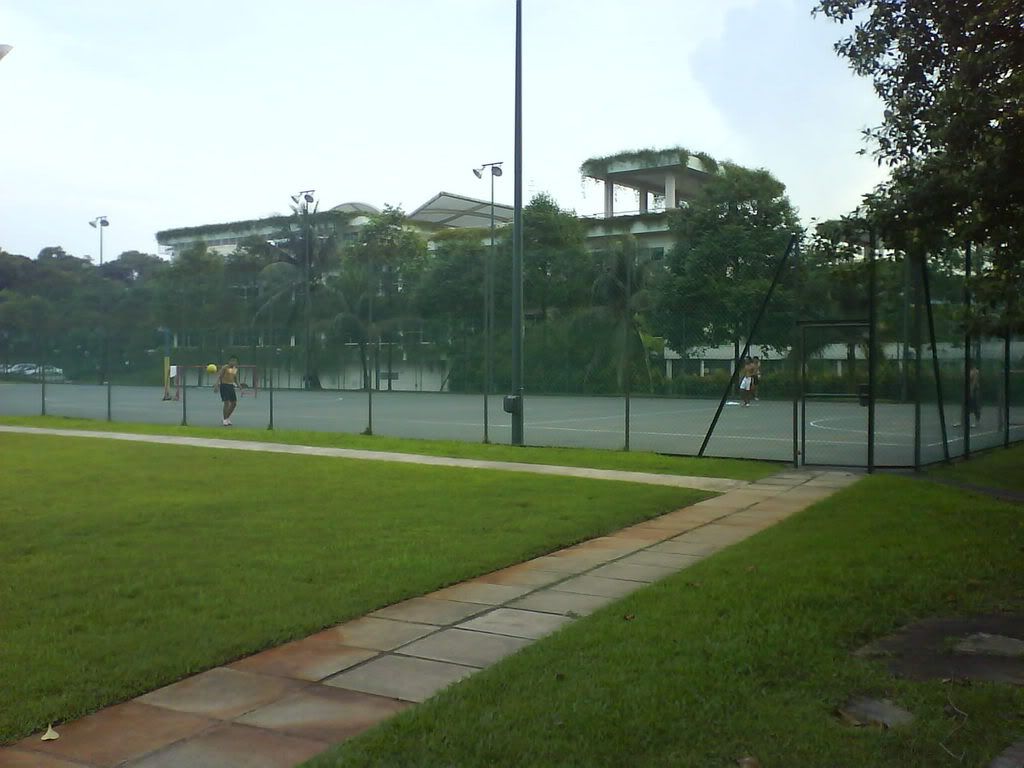SP Multi Purpose Court
Thursday, July 19, 2007
Netball Rules and Regulations ...
The court is divided into thirds which regulate where individuals in each team are allowed to move, and two semi-circular "shooting circles" at each end from within which all scoring shots must be taken.
There are seven players on each team, who are given nominated, named positions. Each player must wear a "bib" showing one of the abbreviations below, indicating that player's position. Each player is only allowed in certain areas of the court: a player in a section of court that is not part of their playing area is deemed "offside". The positions are described below:

By the combination of the above, only the Goal Attack and Goal Shooter are able to score goals directly. A ball that passes through the hoop, but has been thrown either from outside the circle or by a player not the GA or GS, is deemed a "no goal". Furthermore, a shooter (GA or GS) may not shoot for a goal if a "free pass" has been awarded for an infringement such as stepping, offside, or using the post.
Netball rules do not permit players to take more than one step in possession of the ball. Consequently, the only way to move the ball towards the goal is to throw the ball to a team-mate. The ball cannot be held by a player for more than three seconds at any time, and players may not tap the ball to themselves more than once ("replay"). This, combined with the restrictions on where one player can move, ensures that everyone on the team is regularly involved in play. Defence is restricted — contact is only permitted provided it does not impede with an opponent or the general play and players must be at least three feet (90 centimetres) away from a player with the ball mean attempting to defend. If impeding contact is made, a penalty is given to the team of the player who was contacted, and the player who contacted must stand "out of play", meaning they cannot participate in play until the player taking the penalty has passed the ball.
Starting and restarting play

When a the game begins, or after a goal is scored, play begins from the centre of the court with a "centre pass". These passes alternate between the teams, regardless of which team scored the last goal. A centre pass is passed and taken by the Centre player, who must have one foot grounded within the centre circle. As the game restarts, only the teams' Centre players can be in the centre third. When the umpire blows the whistle to restart play, the Goal Attacks, Goal Defences, Wing Attacks and Wing Defences move into the centre third, and the centre pass must be taken by someone who lands within the centre third of the court when they receive the pass. If the ball is not received in the centre third then the opposition receives a "free pass" where the ball was received in the area of infringement. If the ball leaves the court boundaries, then a member of the team that did not touch the ball last restarts play by making a pass from the court linning back into play.
Wednesday, July 18, 2007
Street Soccer Rules and Regulations ...
Each team should consists of a number of 3-7 players, including a goalkeeper for each team. The objective of this game is to score as many goals as possible in order to win the game. The role of the goal keeper is to safeguard the goal line to prevent opposition team from scoring. On the other hand, other players take on the role to score goals or defend opposition's attack.
Rules of a GOALKEEPER
1)A goalkeeper must not score goal
2)The goalkeeper must not leave the penalty area
3)The pass back rule applies. If a goalkeeper picks the ball up with his hands after receiving a pass back from a team mate the other team is awarded a penalty
Rules for PENALTY AREA
1)Outfield players must not enter the penalty area. This rule applies to both attacking and defending players ("fishing for the ball" is not allowed)
2)If a player from the defending team enters the penalty area, the other team receives a penalty
3)If a player from the attacking team enters the penalty area, the other team receives a free kick
A penalty for the opposing team is given when:
1)A player from the defending team enters the penalty area
2)A team passes back three times in a row directly to their own goalkeeper with the intention of time wasting (without a player from the opposing team having had the chance to touch the ball)
3)If the goalkeeper holds the ball longer than necessary in his penalty area (“playing for time”)
4)If the goalkeeper picks up the ball with his hands when he receives a back pass from a player on his own team
5)Due to foul play in front of the goal area
6)A penalty kick must be taken towards the goal. If the ball moves backwards from the goal the penalty is lost













